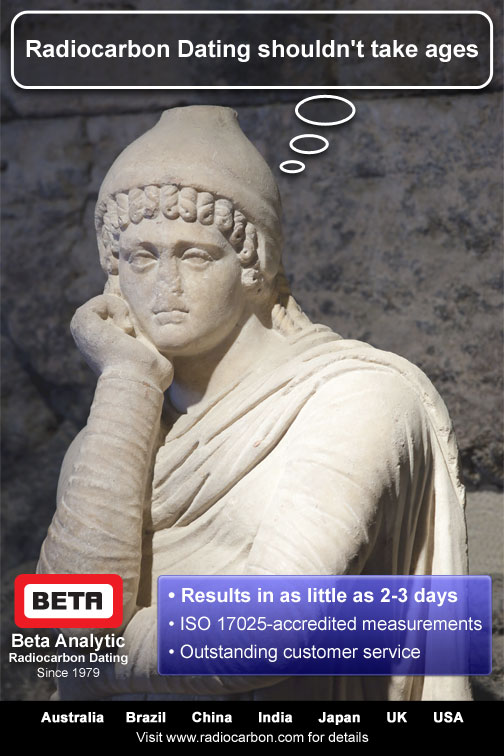Demand a Tracer-Free Laboratory for Radiocarbon Dating
Tuesday, September 16th, 2014
As part of its commitment to provide high-quality results to its clients, ISO/IEC 17025:2005-accredited Beta Analytic does not accept pharmaceutical samples with “tracer Carbon-14” or any other material containing artificial Carbon-14 (14C) to eliminate the risk of cross-contamination. Moreover, the Miami radiocarbon lab does not engage in “satellite dating” – the practice of preparing individual sample graphite in a remote chemistry lab and then subcontracting an AMS facility for the result.
High Risk of Cross-Contamination
Pharmaceutical companies evaluate drug metabolism by using a radiolabeled version of the drug under investigation. AMS biomedical laboratories use 14C as a tracer because it can easily substitute 12C atoms in the drug molecule, and it is relatively safe to handle. Tracer 14C is a well-known transmittable contaminant to radiocarbon samples, both within the AMS equipment and within the chemistry lab.
Since the artificial 14C used in these studies is phenomenally high (enormous) relative to natural levels, once used in an AMS laboratory it becomes ubiquitous. Cross-contamination within the AMS and the chemistry lines cannot be avoided. Although the levels of contamination are acceptable in a biomedical AMS facility, it is not acceptable in a radiocarbon dating facility.
Biomedical AMS facilities routinely measure tracer-level, labeled (Hot) 14C samples that are hundreds to tens of thousands of times above the natural 14C levels found in archaeological, geological, and hydrological samples. Because the 14C content from the biomedical samples is so high, even sharing personnel will pose a contamination risk; “Persons from hot labs should not enter the natural labs and vice versa” (Zermeño et al. 2004, pg. 294). These two operations should be absolutely separate. Sharing personnel, machines, or chemistry lines run the risk of contaminating natural level 14C archaeological, geological, and hydrological samples.
Avoid the Risks
Find out from the lab that you are planning to use that they have never in the past and will never in the future:
– accept, handle, graphitize or AMS count samples containing Tracer or Labeled (Hot) 14C.
– share any laboratory space, equipment, or personnel with anyone preparing (pretreating, combusting, acidifying, or graphitizing) samples that contain Tracer or Labeled (Hot) 14C.
– use AMS Counting Systems (including any and all beam-line components) for the measurement of samples that contain Tracer or Labeled (Hot) 14C.
Tracer-Free Lab Required
Recently, federal contracts are beginning to specify that AMS laboratories must be 14C tracer-free facilities in order to be considered for participation in solicitations.
A solicitation for the National Oceanic and Atmospheric Administration (NOAA) has indicated that “the AMS Facility utilized by the Contractor for the analysis of the micro-samples specified must be a 14C tracer-level-free facility.” (Solicitation Number: WE-133F-14-RQ-0827 – Agency: Department of Commerce)
For ASTM D6866-16, ASTM International limits application of the standard to “laboratories working without exposure to artificial carbon-14 (14C).” Artificial radiocarbon can exist within the lab at levels 1,000 times or more than 100 % biobased materials and 100,000 times more than 1% biobased materials. Once in the laboratory, artificial 14C can become undetectably ubiquitous on door knobs, pens, desk tops, and other surfaces but which may randomly contaminate an unknown sample producing inaccurately high biobased results.
As a natural level radiocarbon laboratory, Miami-based radiocarbon lab Beta Analytic highly recommends that researchers require the AMS lab processing their samples to be tracer-free.
Useful References
1. Memory effects in an AMS system: Catastrophe and Recovery. J. S. Vogel, J.R. Southon, D.E. Nelson. Radiocarbon, Vol 32, No. 1, 1990, p. 81-83
doi:10.2458/azu_js_rc.32.1252 (Open Access).
“ . . .we certainly do not advocate processing both labeled and natural samples in the same chemical laboratory.” “The long term consequences are likely to be disastrous.”
2. Recovery from tracer contamination in AMS sample preparation. A. J. T. Jull, D. J. Donahue, L. J. Toolin. Radiocarbon, Vol. 32, No.1, 1990, p. 84-85 doi:10.2458/azu_js_rc.32.1253 (Open Access).
“. . . tracer 14C should not be allowed in a radiocarbon laboratory. “ “Despite vigorous recent efforts to clean up the room, the “blanks” we measured had 14C contents equivalent to modern or even post‐bomb levels. “
3. Prevention and removal of elevated radiocarbon contamination in the LLNL/CAMS natural radiocarbon sample preparation laboratory. Zermeño, et. al. Nuclear Instruments and Methods in Physics Research Section B: Beam Interactions with Materials and Atoms
Vol. 223-224, 2004, p. 293-297
doi: 10.1016/j.nimb.2004.04.058
“The presence of elevated 14C contamination in a laboratory preparing samples for natural radiocarbon analysis is detrimental to the laboratory workspace as well as the research being conducted.”
4. High level 14C contamination and recovery at XI’AN AMS center. Zhou, et. al. Radiocarbon, Vol 54, No. 2, 2012, p. 187-193
doi:10.2458/azu_js_rc.54.16045
“Samples that contain high concentrations of radiocarbon (“hot” samples) are a catastrophe for low background AMS laboratories.” “In our case the ion source system was seriously contaminated, as were the preparation lines.”
5. ASTM D6866-16 – Standard Test Methods for Determining the Biobased Content of Solid, Liquid, and Gaseous Samples Using Radiocarbon Analysis
Last Updated: July 22, 2016

SEND SAMPLES |
|---|
| Contact us for prices |
| Prepare Sample |
| Submit Data Sheet Online |
| See Shipment Guidelines |
| Shipping Addresses |
Carbon 14 Dating ServiceWould you like us to track your package? Are you filling out the online form? Read about sample material return Beta Analytic Other Services- d13C and d15N - d18O for carbonates - d2H and d18O for water |
Terms and Conditions



